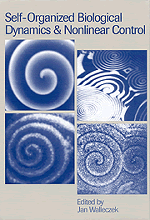 Self-Organized Biological Dynamics and Nonlinear Control
Self-Organized Biological Dynamics and Nonlinear Control Published online by Cambridge University Press: 14 August 2009
Introduction
The human brain is composed of 100 billion to a trillion neurons and as many neuroglia. The human-and-environment system is open and complex. Human behavior is adaptive and multifunctional, arising from interactions that occur on many levels among diverse organizational components. How is the vast material complexity of the brain on the one hand and the behavioral complexity that emerges on the other to be understood? In this chapter we describe experiments that illustrate recent research efforts aimed at uncovering the basic principles and mechanisms governing the brain and behavioral function. In particular, we focus on the following specific questions. (1) How do we react to and coordinate with the environment (see Section 4.2), and (2) how do we perceive and categorize the world around us (see Section 4.3)? Our work is based on the joint premises that a more complete understanding of how the brain works will come: (1) when experimental research in the laboratory is combined with new theoretical approaches investigating how the brain functions as a whole; and (2) as a result of direct, multidisciplinary collaborations between neuroscientists, experimental psychologists, mathematicians and physicists.
Evidence for self-organized dynamics from a human sensorimotor coordination experiment
One of the simplest forms of human–environment coordination involves producing motor outputs at a specific timing relationship with regular external events. Many human activities such as music and dance depend on the efficient execution of this sensorimotor task.
To save this book to your Kindle, first ensure [email protected] is added to your Approved Personal Document E-mail List under your Personal Document Settings on the Manage Your Content and Devices page of your Amazon account. Then enter the ‘name’ part of your Kindle email address below. Find out more about saving to your Kindle.
Note you can select to save to either the @free.kindle.com or @kindle.com variations. ‘@free.kindle.com’ emails are free but can only be saved to your device when it is connected to wi-fi. ‘@kindle.com’ emails can be delivered even when you are not connected to wi-fi, but note that service fees apply.
Find out more about the Kindle Personal Document Service.
To save content items to your account, please confirm that you agree to abide by our usage policies. If this is the first time you use this feature, you will be asked to authorise Cambridge Core to connect with your account. Find out more about saving content to Dropbox.
To save content items to your account, please confirm that you agree to abide by our usage policies. If this is the first time you use this feature, you will be asked to authorise Cambridge Core to connect with your account. Find out more about saving content to Google Drive.